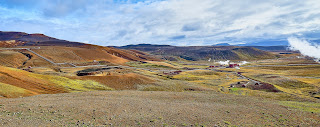We left late morning for a drive to some sites near Akureyri. The area in which we spent much of the time today and on day 7, was around Mývatn lake. Mývatn is a shallow lake situated in an area of active volcanism just south of Akureyri and not far from the Krafla volcano. The lake and its surrounding wetlands have a rich fauna of waterbirds. Mývatn lake was created by a large basaltic lava eruption 2300 years ago, and the surrounding landscape is dominated by volcanic landforms, including lava pillars (which we will see later) and pseudocraters (also about which more later).
First to a falls, Goðafoss (foss means falls) - Waterfall of the Gods. To reach Goðafoss we took a small detour off the main road just south of lake Mývatn.
Like Gullfoss, though neither as high nor tiered, this is a beautiful cascade of blue-green water tumbling over a broad expanse of the cliffs into the river below.
Definitely worth the visit and the short walk down to the base of the falls. I’m including a few photos of these falls as I like them all and hope that you do as well.
From Goðafoss we continued on around the south portion of lake Mývatn to the town of Reykjahlið where we took a bit of time to review what we wanted to see here and how we would proceed.
We decided to go up to the Krafla area (Krafla is an 800 meter mountain but the entire area around including the geothermal power station is referred to as Krafla).
The area around the mountain is an active volcanic region where there is much steam pouring from numerous fumaroles.
In the valley there is a geothermal power station which harnesses all this geothermal activity and sends it through an impressive collection of pipes snaking across the landscape into a complex distribution system. At some point these pipes go underground, surfacing again at intervals where there are small small concrete sheds, which we guess are maintenance and check point areas.
At the top of what we assumed to be the mountain, Krafla, there was also a crater which turned out to be quite underwhelming though the view into the valley below was excellent.
Shortly we learned that, nearby, there is a crater, Leirhnjúkur, which is more impressive than the one on Krafla. Getting to it involved a 3 or 4 Km (round trip) walk in sunny but quite cold, windy conditions through areas of bubbling, steaming mud pots. I had left my gloves in the car so my hands got sufficiently cold that using the camera was a bit difficult.
 |
| In the Krafla valley near a small hot pond. |
According to one source, Leirhnjúkur originally appeared in 1727 as a lava fountain, spewing molten material for 2 years before becoming quiet.
 |
| On the walk to Leirhnjúkur - note steam on the hillside. |
In 1975 a small eruption in Leirhnjúkur led to the Krafla fires which apparently went on for nine years leaving the smouldering remnants seen today.
 |
| At the Leirhnjúkur site |
In the photo above the closest two sulfurous steam plumes are the result of extremely hot water blasting out with extreme force from a pipe in the ground into the pond water.
It is said that the earth’s crust is extremely thin here (photo left) so the surface is very hot which likely accounts for the steam rising from the rocks.
 |
| Steaming hot mud pond |
 |
| Michael and Rod checking out the lava material in the crater wall. |
This was an amazing site of a relatively recently erupted volcano with smouldering black lava rock strewn over a huge area.
The photos fail to show the extent of the area over which the extruded material travelled.
 |
| Hot mud pot. |
From Leirhnjúkur and the cold walk back to the car we moved on to the warmth of the Myvatn nature baths in which we languished for over an hour. I didn’t realize it at the time but have since learned that this bath is not a natural bath but rather man made and heated by hot water from the nearby geothermal power station. Now, you may recall my comment about visiting Iceland being expensive - another example of this was the cost of the bath for three of us (two seniors fares) came to just under $200 CND! But as it included 2 beers we gave it not another thought and thoroughly enjoyed our hour or so in the luxurious warmth of the geothermally heated water.
Tomorrow we plan to spend time relaxing in the hot tub at “home” before going for lunch, shopping and just strolling around the lovely town of Akureyri.






No comments:
Post a Comment